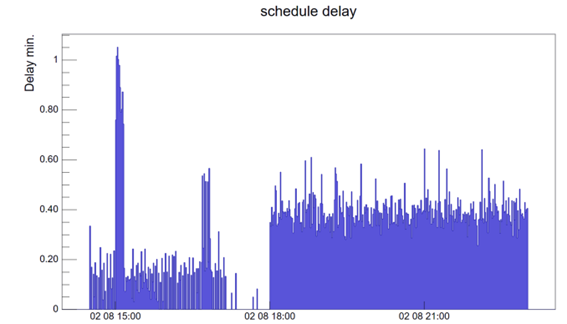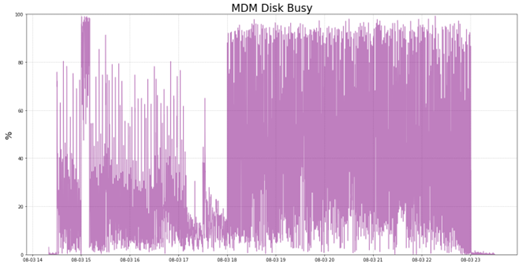Let’s discover how performance scenarios react to new security and general features released in version 10.2 in a couple of test environments.
Performance Test Results Overview
Going briefly to describe performance results for the new version of the product, 10.2, by comparing to the results achieved with previous versions (for more details about previous version results, see Workload Scheduler 9.5.0.2 performance report and Workload Scheduler 10.1.0.1 Performance Report ).
Let’s start with the Scheduling Delay for version 10.2. The product shows pretty much the average delays as previous versions. Figure 1 shows the delay in the first test environment.
Going briefly to describe performance results for the new version of the product, 10.2, by comparing to the results achieved with previous versions (for more details about previous version results, see Workload Scheduler 9.5.0.2 performance report and Workload Scheduler 10.1.0.1 Performance Report ).
Let’s start with the Scheduling Delay for version 10.2. The product shows pretty much the average delays as previous versions. Figure 1 shows the delay in the first test environment.
Figure 1 Average job schedule delay per minute over time
· About mirroring delay, for all levels of the scheduling workload (peak, plateau etc.), both test environments present the same mirroring delays as previous versions.
· Analyzing the CPU utilization, in the environments where the new security feature was not enabled, the average CPU utilization is slight increased for both master domain manager and RDBMS machines. Instead, in the test environments where the "encryption at rest" was enabled, a significant increase of CPU utilization could be noticed for the master domain manager only, while for the RDBMS the utilization seemed to be the same. The increase of security level could coexist with the new performance results!
· About mirroring delay, for all levels of the scheduling workload (peak, plateau etc.), both test environments present the same mirroring delays as previous versions.
· Analyzing the CPU utilization, in the environments where the new security feature was not enabled, the average CPU utilization is slight increased for both master domain manager and RDBMS machines. Instead, in the test environments where the "encryption at rest" was enabled, a significant increase of CPU utilization could be noticed for the master domain manager only, while for the RDBMS the utilization seemed to be the same. The increase of security level could coexist with the new performance results!
Figure 2 Total average CPU utilization at master domain manager vs different workload
· Regarding disk utilization, in the environments where the new security feature was not enabled, the average disk utilization slightly increased for the master domain manager at maximum load, while for the RDBMS, the increase was higher. Instead, in the test environments where the "encryption at rest" was enabled, the disk utilization slightly increased for both the master domain manager and RDBMS.
· Regarding disk utilization, in the environments where the new security feature was not enabled, the average disk utilization slightly increased for the master domain manager at maximum load, while for the RDBMS, the increase was higher. Instead, in the test environments where the "encryption at rest" was enabled, the disk utilization slightly increased for both the master domain manager and RDBMS.
Conclusion
If you are curious to know more details about the topic, see the full report version 10.2 HERE
For any questions, feel free to contact us.
If you are curious to know more details about the topic, see the full report version 10.2 HERE
For any questions, feel free to contact us.
| Lorenzo Nichele Lorenzo joined HCL in July 2022 as Performance Test Engineer in the Workload Automation team. Specifically, Lorenzo works to both run performance tests and monitor the data obtained from tests, implementing tools and analyses typical of Data Science. Lorenzo has a master's degree in biomedical engineering and is currently based in the HCL Software Rome software development laboratory. |




